
For any organisation, existing customers provide unrivalled levels of insight into how people engage with that brand. But few brands are utilising this data to increase their reach through social media and, most crucially, drive new customers through targeted social ads.
Our latest whitepaper, How to drive ROI from social advertising, discusses how first party CRM data can provide a considerable amount of data regarding a brand’s current customer base. This data, amongst other things, highlights how active audiences are in particular product areas and how they engage with your brand – critical pieces of insight for social ad campaigns. When combined with the data that is now available through social networks, brands can drive significantly improved ROI from social media advertising.
Segmentation of audiences
For many marketers, making sense of this data represents a huge headache. A 2015 Econsultancy Report found that two thirds of marketers believed that an “overwhelming amount of data” was a notable concern.
The key to making sense of this data, and generating actionable insight from it, lies in the segmentation of the data.
By focusing on target groups based on their profitability to your business, or frequency of purchase, you are only going to analyse your “most valuable” customers. This reduces the likelihood targeting campaigns at audiences that have a low propensity to convert.
Typically, this data would segment into five key areas.

Lifetime value
This represents the total value of a consumer group over the course of the consumer lifestyle. The more valuable the customer group, the more you should focus on targeting them with social media activity.
Highest basket value
Highest basket value (and similarly, average basket size) allows you to identify consumer groups that may not necessarily have the largest lifetime value, but who typically purchase more products, or more valuable products, in one purchase.
Most frequent purchasers
These are your most loyal or most active consumers. They are people who trust your brand, you continue to engage with your brand and who are likely to be more receptive to your brand advertising campaigns.
Location concentration
Does your brand have an audience that is focused around certain geographic areas? If so, build this into your targeting strategy.
This will be particularly important for local and regional businesses, but even large multinationals are likely to find strength in certain geographic regions, be that a particular group of cities, counties, states or countries.
Channel acquired
Understanding where your customers have come from is equally as crucial. A user who has converted for your brand via online channels such as PPC, display or remarketing are likely to spend more average time online than phone or direct mail consumers, and will likely be easier to build an online profile for, whilst being more responsive to online social advertisements.
Targeting new audiences
Segmenting your audiences into these categories provides you with a clear indication as to who your most valuable customers are, and which ones require greater levels of incentivisation. This is where lookalike marketing really becomes powerful.
It stands to reason that, unless your organisation is planning a significant step-change in the audiences that it targets, the audiences that you want to attract are likely to have very similar demographic and behaviour patterns to the ones that are already engaged with your brand.
It means that these audience personas become incredibly powerful when you come to expanding your brand reach through lookalike marketing campaigns that target new audiences based on the behavioural and demographic traits of your existing customer groups. The more segmented your audience is, the more specifically you can target new audience groups and the more focused your campaign can be on targeting those audiences that are most likely to engage with your brand.



